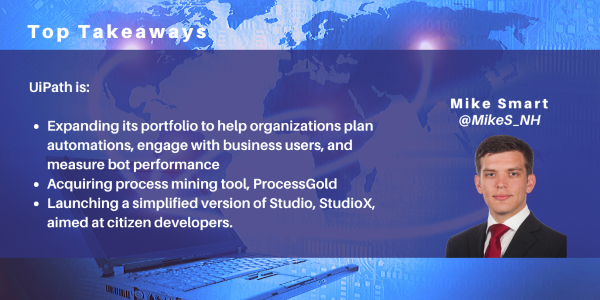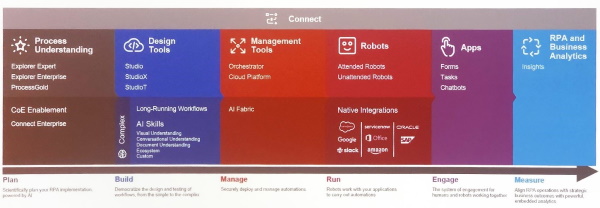Search posts by keywords:
Filter posts by author:
Related NEAT Reports
Other blog posts
posted on Oct 24, 2019 by Mike Smart

Reboot work was the slogan for UiPath’s recent Forward III partner event, a reference to rethinking the way we work. UiPath’s vision is to elevate employees above repetitive and tedious tasks to a world of creative, fulfilling work. The company’s vision is driven by an automation first mindset, along with the concept of a bot for everyone and human-automation collaboration.
During the event, which attracted ~3K attendees, UiPath referenced ~50 examples of clients at scale, and pointed to a sales pipeline of more than $100m.
Previously, UiPath’s automation process had three phases: Build, Manage, and Run, using Studio, Orchestrator, and Attended and Unattended bots respectively. Their new products extend this process to six phases: Plan, Build, Manage, Run, Engage, and Measure. In this blog, I look at the six phases of the UiPath automation process and at the key automation products at each stage, including new and enhanced products announced at the event.

Plan phase (with Explorer Enterprise, Explorer Expert, ProcessGold, and Connected Enterprise)
By introducing the product lines Explorer and Connected Enterprise, UiPath aims to allow RPA developers to have a greater understanding of the processes to be automated when planning RPA development.
Explorer consists of three components, Explorer Enterprise, Explorer Expert, and ProcessGold. Explorer provides new process mapping and mining functionality building on two UiPath acquisitions: the previously announced SnapShot, which now comes under the Explorer Enterprise brand, and the newly announced ProcessGold whose existing clients include Porsche and EY. Both products construct visual process maps in data-driven ways; Explorer Enterprise (SnapShot) does this by observing the steps performed by a user for the process, and ProcessGold does this by mining transaction logs from various systems.
Explorer Enterprise performs task mining, with an agent sitting in the background of a user machine (or set of users’ machines) for 1-2 weeks. Explorer then collects details of the user activities, the effort required, the frequency of the activity, etc.
ProcessGold, on the other hand, monitors transaction logs and, following batch updates and 2 to 3 hours of construction, builds a process flow diagram. These workflow diagrams show the major activities of the process and the time/effort required for each step, which can then be expanded to an individual task level. Additionally, at the activity level, the user has access to activity and edge sliders. The activity slider expands the detail of the activities, and the edge slider expands the number of paths that the logged users take, which can identify users possibly straying from a golden path.
Administrators can then use the data from Explorer Enterprise and/or ProcessGold in Explorer Expert. Explorer Expert allows the admin users to enter deeper organizational insights, and either record a process to build or manually create a golden path workflow. These workflows act as a blueprint to build bots and can be exported to Word documents which can then be used by bot creators.
Connected Enterprise enables an organization to crowdsource ideas for which processes to automate, and aims to simplify the automation and decision-making pipelines for CoEs.
Automation ideas submitted to Connected Enterprise are accompanied by process information from the submitter in the form of nine standard questions, such as how rule-based it is, how likely to change it is, who the owner is, etc. as well as process owners. This information is crunched to produce automation potential and ease of implementation scores to help decide on the priority of the automation idea. These ideas are then curated by admins who can ask the end-user for more information, including an upload of ProcessGold files.
The additions of Explorer and Connected Enterprise allow developers to gain deeper insights into the processes to be automated, and business users to connect with RPA development.
Build phase (with enhanced Studio, plus new StudioX & StudioT)
New components to the build phase include StudioX and StudioT along with a number of enhancements to the existing Studio bot builder.
StudioX is a simplified version of the Studio component which is targeted at citizen developers and regular business users, which UiPath referred to ‘Excel power user level’, to create more simplistic bots as part of a push for citizen developers and a bot for every person.
StudioX simplifies bot development by removing the need for variables, and reduces the number of tasks that can be selected. Bots produced with StudioX can be opened with Studio; however, the reverse may not necessarily be the case depending on the components used in Studio.
The build-a-bot demo session for StudioX focused on using Excel to copy data in and out of HR and finance systems and extracting and renaming files from an Outlook inbox to a folder. Using StudioX in the build-a-bot session was definitely an improvement over Studio for the creation of these simple bots.
StudioT, which is in beta and set to release Q1 2020, will act as a version of Studio focused entirely on testing automation. NelsonHall’s software testing research, including software testing automation, can be found here.
Further key characteristics of the existing build components include:
- Long-running workflows which can suspend a process, send a query to a human while freeing up the bot, and continuing the bot once the human has provided input
- Cloud which has a 1-minute signup for the Community version of the aaS platform and (as of September 2019) has 240k users, up from 167k in June 2019
- Queue triggers which can automatically take action when items are added to the queue
- More advanced debugging with breakpoint and watch panels
- Taxonomy management
- Validation stations.
With the introduction of StudioX, UiPath aims to democratize RPA development to the business users, at least in simple cases; and with long-running workflows, human-bot collaboration no longer requires bots to sit idle, hogging resources while waiting for responses.
Manage phase (with AI Fabric)
The Manage phase now allows users to manage machine learning (ML) models using AI Fabric, an add-on to Studio. It allows users to more easily select ML models, including models created outside of UiPath, and integrate them into a bot. AI Fabric, which was announced in April 2019, has now entered private preview.
Run phase (with enhancements to bots with native integrations)
Improvements to the run components leverage changes across the portfolio of Plan, Build, Manage, Run, Engage, and Measure, in particular for attended bots with Apps (see below). Other new features include:
- Expanding the number of native integrations, for which UiPath and its partners are building 100s of connectors to business applications such as Salesforce and Google to provide functionality including launching bots from the business application. Newer native applications are available via the UiPath Go! Storefront
- A new tray will feature in the next release.
Engage phase (allowing users direct connection to bots with Apps)
Apps act as a direct connection for users to interact with attended bots through the use of forms, tasks, and chatbots. In Studio, developers can add a form with the new form designer to ask for inputs directly from the user. For example, combined with an OCR confidence score, a bot could trigger a form to be filled in should the confidence score of the OCR be substandard due to a low-quality image.
Bots that encounter a need for human intervention through Apps will automatically suspend, add a task to the centralized inbox, and move on to running another job. When a human has completed the required interaction, the job is flagged to be resumed by a bot.
With the addition of Apps, the development required to capture inputs from the business users is minimized to allow for a deeper human-bot connection, reduction of development timelines, and helping to enable the goal of ‘a bot for every person’.
Measure phase (now with Insights to measure bot performance)
Insights expands UiPath’s reporting capabilities. Specifically, Insights features customizable dashboarding facilities for process and bot metrics. Insights also features the ability to send pulses, i.e. notifications, to users on metrics, such as if an SLA falls below a threshold. Dashboards can be filtered on processes and bots and can be shared through a URL or as a manually sent or scheduled PDF update.
What does this mean for the future of UiPath?
While UiPath and its competitors have long-standing partnerships with the likes of Celonis for process mining, the addition of native process mining through the acquisitions of SnapShot and ProcessGold, in addition to the expanded reporting capabilities, position UiPath as more of an end-to-end RPA provider.
With ProcessGold, NelsonHall believes that UiPath will continue the development of Explorer, which could lead to a nirvana state in which a client deploys ProcessGold, ProcessGold maps the processes and identifies areas that are ideal for automation, and Explorer Expert helps the bot creator to design this process by linking directly with Studio. While NelsonHall has had conversations with niche process mining and automation providers that are focusing on developing bots through a combination of transaction logs and recording users, UiPath is currently the best positioned of the big 3 intelligent automation platform providers to invest in this space.
StudioX is a big step towards allowing citizen developers. During our build-a-bot session, it was clear that the simplified version of the platform is more user-friendly, resulting in the NelsonHall team powering ahead of the instructor at points. However, we were somewhat concerned that while StudioX opens up the ability to develop bots to a larger scope of personae, the slight disconnects between Studio and StudioX could lead to users learning StudioX and wanting to leverage activities that are currently restricted to Studio (such as error handling) becoming frustrated. NelsonHall believes that the lines between Studio and StudioX will blur, with StudioX receiving simplified functions currently restricted to Studio, which will enable more bots to be passed between the two personae.
Conclusion
With the announcements at the Forward III event, it is clear that UiPath is enabling organizations to connect the business users directly with automation; be that through citizen developers with StudioX, the Connected Enterprise Hub to forge stronger connections between business users and automation CoEs, Explorer to allow the CoE to have greater understanding of the processes, or Apps to provide direct access to the bot.
This multi-pronged push approach to connect the developer and automation to the business user will certainly reduce frustrations around bot development and reduce the feeling from business users that automation is something that is thrust upon them rather than being part of their organization's journey to a more efficient way of working.
